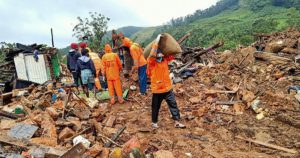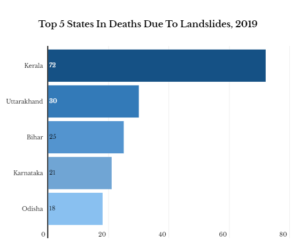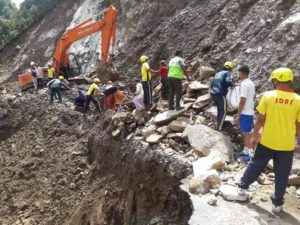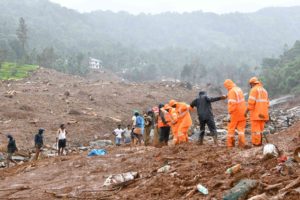Six days of relentless rain had saturated the soil on the rolling slopes of Rajamala hamlet in Anamalai hills – which support tea and coffee plantations – in Idukki district of Kerala. On August 6, the downpour became especially torrential, forcing a portion of the hills to move, triggering a landslide that brought boulders and slurry crashing down on a settlement of tea estate workers in Pettimudi valley, killing 70 people and flattening rows of tin-roofed houses.
Although monsoon rains cause landslides every year, economic activities and the climate crisis are increasing the risk, especially in the Himalayas and the Western Ghats.
Last year, 264 Indians died in landslides, said a report on accidental deaths and suicides in 2019 by the National Crime Records Bureau. Over 65% of these fatalities happened in the Himalayas and the Western Ghats.

Casualties, however, do not reflect the true impact of a landslide. Unlike other natural disasters such as lightning, the effects of landslides can last years – in the shape of displacement, deforestation and damage to property, fields, roads and water supplies, having a cascading effect on the local economy. A 2011 estimate suggested that India suffers Rs 150 crore to Rs 200 crore of monetary loss every year from landslides, said a study by the National Institute of Disaster Management.
Further, their emotional toll on survivors cannot be quantified, as in the case of Tashma Muthappa of Second Monnangeri village in the hilly Kodagu district of Karnataka, among the worst flood – and landslide-affected locations in Kodagu during the 2018 monsoon.
When Muthappa returned to her village from a relief camp, she found only a sidewall and foundation where her home had once stood. It had been just a year and a half since her family had constructed the house at a cost of Rs 25 lakh. It had rained incessantly for 15 days.
“On the morning of August 17, 2018, we watched large rocks roll downhill, and fled,” she recalled. “Around 60 of us trekked through hills and the forest to reach a relief camp by night. Roads were blocked due to landslides and mobile networks were down.”
An international throwball player, 25-year-old Muthappa was engaged to marry in December of that year. The jewellery, worth Rs 3.5 lakh, bought for the wedding was washed away along with Rs 50,000 in cash, besides her medals, trophies and certificates. After her story went viral on social media, help poured in from philanthropists who supported the family to pay rent and meet other expenses for one year.
Human intervention
A landslide is a large movement of rock, debris or earth triggered by natural causes such as earthquakes or heavy rainfall. But human activity such as the construction of roads, buildings and railways, mining and quarrying and hydropower projects also damage hilly slopes and impact natural drainage by removing soil and vegetation, loosening soil and gravel and making the hills more susceptible to landslides. In India, 4,20,000 sq km, or 12.6% of the total land, is landslide-prone.

India was one of the countries most affected by human-triggered fatal landslides in the 2004-’16 period, found a study by researchers at Sheffield University, UK. Analysing 5,031 fatal landslides worldwide, the study showed that India registered around 10,900 deaths from 829 landslides, which made up 18% of the total global casualties.
India accounted for 28% of construction-triggered landslide events, followed by China (9%), and Pakistan (6%). On the other hand, of the total landslides triggered by rainfall, 16% were reported from India. Of these, 77% occurred during the monsoon. India also accounted for maximum landslides triggered by mining, at 12%, followed by Indonesia (11.7%), and China (10%).
Around 4 a.m. on April 17, 2012, water leakage from the headrace tunnel of the Chamera III hydropower project in Chamba district of Himachal Pradesh destabilised the slope. Around 40 families staying in the downhill Mokhar village scrambled to safety before a landslide took down their homes and around 100 bigha (1 bigha = 0.08 hectare) of terraced farms within a couple of hours.
“We were given [money for] house rent for one year and the project proponent acquired our land at Rs 6.80 lakh per bigha,” said Devi Lal, former pradhan of Mokhar, who was among 74 people who challenged the compensation amount as inadequate. Activists have been campaigning against hydropower projects in the Himalayas citing incidents like these as proof that the geology is too fragile to accommodate large-scale development.
Unplanned development
A study analysing building regulations in eight towns in the Himalayan region found that these building bylaws do not make provisions for the particular geo-environmental context of a settlement. The same land use regulations apply regardless of topographical location, slope angle and direction, and the hazard potential of a site.

The National Landslide Risk Management Strategy published by the National Institute of Disaster Management in September 2019 also flagged this anomaly. The regulations are “mostly inspired from Delhi Master Plan(s), which are not appropriate to the context of hill towns, as the geo-environmental and socio-developmental context of Delhi is varied to a greater extent from that of hill towns”, it said. Lack of local land use planning or its updation in the urban local bodies of the Himalayan region and the Western Ghats is resulting in “ill-conceived planning, unplanned development and ultimately slope instability”.
Extreme weather
Severe, unpredictable weather events such as heavy, intense rainfall due to the climate crisis are adding another layer of complexity to landslide incidents in the country. For instance, Kerala received 164% more rainfall than normal from August 1 to August 19, 2018, resulting in severe flooding and landslides that killed 498 people. Nearly 341 landslides were reported from 10 districts. Idukki district was ravaged by 143 landslides.
Although this was termed a once-in-a-century event, intense rainfall episodes battered the state again the following year, and this year – as seen at Pettimudi that did not even fall in the landslide hazard zone because of its remote location among forests and tea estates.
“Poor quality of soil due to forest fragmentation and mono-cropping may have contributed to the disaster but the biggest reason was rainfall,” said Sarun Savith, assistant professor of geography with Kerala-based Sree Sankaracharya University of Sanskrit, who has developed climate crisis vulnerability index for all districts of Kerala. “The monsoon pattern in Kerala has changed drastically over the last 10 years. While the number of rainy days has reduced, the amount of rainfall remains the same, which means we are getting more intense rains.”

“The region used to get maximum rainfall in June, and August would be a dry month and hence marked for celebrations like Onam,” said Savith. “But now, we are getting the maximum rainfall in August when the ground is already saturated and hence there are more chances of landslides.”
In India, many of the vulnerable slopes also lie in highly hazardous seismic zones. For example, half of Uttarakhand and the entire North-East lies in Zone V, the most seismically active categorisation.
Mapping landslides can minimise damage
Improvement in early warning systems, monitoring and susceptibility zoning can reduce the damage caused by landslides.
The Geological Survey of India has done a national landslide susceptibility mapping at 1:50,000 scale for 85% of the entire 4,20,000 square km landslide-prone area in the country and is trying to complete the rest in the next two years. The areas have been divided into different zones according to the propensity of the disaster. (Map scale refers to the ratio between the distance on a map and the corresponding distance on the ground. On a 1:50,000 scale, 1 cm on the map would denote 0.5 km on the ground.) Efforts are afoot to create maps that offer even greater accuracy in high hazard areas.
“These maps at 1:50,000 scale can be used to regulate land use in hilly/mountainous areas,” said Saibal Ghosh, director, Landslide Studies Division, Geohazards Research and Management Centre, Geological Survey of India. “For instance, areas with higher landslide probability can be spared big infrastructure.”
“This would not only help avoid many new landslides that are caused heavily by human interventions but also reduce damages to life and property if an incident happens,” said Ghosh.
The maps, however, need to be localised to give a more magnified view of the locality to be more useful. This would help building plans and local construction activities said Ghosh adding that Geological Survey of India is working on upscaling its zonation work.
“We will cover 200 sectors on 1:10,000 scale and 100 site-specific landslide investigations on 1:1,000 scale in the next five years on requests received from the state governments concerned or road-maintenance authorities,” said Ghosh, “This requires intense field work besides remote sensing and hence takes more time.”
Planning ahead
Mizoram’s capital city Aizawl, which falls in the most seismically active Zone V, has taken a lead over other hill towns in this aspect. It has developed a landslide action plan using 1:5,000 scale susceptibility maps and new regulations to guide construction activities.
“Aizawl is built on steep slopes of very fragile mountains,” said Hari Kumar, regional coordinator for South Asia at GeoHazards International, a non-profit working on disaster management. “We created an earthquake scenario which showed that if a magnitude seven earthquake strikes 50-km away from Aizawl, around 1,000 landslides will get triggered, collapsing 13,000 buildings, blocking roads and also cutting the critical electricity and water supply lines”
“Around 25,000 people would be killed because of the immediate impact of the earthquake and also because of not being rescued in time as the access routes would also be blocked,” Kumar said.
Aizawl Municipal Corporation has set up a landslide policy committee involving stakeholders from various departments and researchers to prepare a long-term safety plan. University students were involved to prepare susceptibility maps at 1:5,000 scale, identifying the risk zones.
New site development and slope modification regulations will be put in practice soon. Under these bylaws, any site development in hazard-risk zones will require a report by a geologist or geotechnical engineer assessing: the soils and stability of slopes; the potential effects of the proposed construction on the surroundings; recommendations for corrective measures such as retention walls or buttress fills, if required; and mitigation measures such as for slope stabilisation. This report will be reviewed by the Geologic Review Board of the Aizawl Municipal Corporation before a permit for construction is given.
“This would mean no one is allowed to endanger the lives of others by building haphazardly,” said Zohmingthanga, executive engineer with the Aizawl Municipal Corporation. “We have also identified six most-hazardous spots for landslides and currently, a physical survey of these areas is underway.”
“These areas will be prohibited from any construction activity in future,” Zohmingthanga said. “Our long-term plan is to prepare neighbourhood susceptibility maps at 1:500 scale and also have more sophisticated landslide monitoring equipment.”
After years of facing tragedies, Kerala is also trying to ensure disaster-resilient development in its hilly regions. The “Rebuild Kerala” action plan has given high priority to preparation of landslide hazard zonation maps in hilly areas at the municipality and panchayat levels. A landslide management strategy with mitigation measures like slope protection will be implemented and building rules will be amended considering the local risk patterns, the action plan says.
Monitoring for early warning
Local geographical indicators offer warning signs for landslides. New cracks, unusual bulges and depressions in the ground, tilting trees, telecom poles or retaining walls, soil moving away from foundations and sudden increase in water flow in streams with more mud, or decrease in flow when it is still raining or rainfall has recently stopped, can signal landslides.
Rainfall is a key indicator. The Geological Survey of India started an experiment in Landslide Early Warning System in July in the districts of Darjeeling (West Bengal) and the Nilgiris (Tamil Nadu), which could be expanded to other landslide-prone states if it proves successful. The model is based on rainfall threshold, which is the amount of rainfall a slope can hold before a landslide gets triggered, which is estimated using past cumulative rainfall data combined with landslide susceptibility data.
Using the Geological Survey of India system, the Nilgiris administration evacuated around 1,000 people in the first week of August from risky locations during heavy rains. “We were able to act based on bulletins issued by both the India Meteorological Department and Geological Survey of India.
While IMD gave us a district-wise forecast, Geological Survey of India bulletins had information about blocks which could face disasters. That helped us focus energies on these areas only,” said district collector J Innocent Divya. “But we would need more specific information and have asked Geological Survey of India to improve it and also add information about potential cloud bursts which, the past data show, trigger massive landslides.”
Cloudburst is a highly localised phenomenon involving more than 100 mm of rainfall in one hour. The Uttarakhand flood of 2013 was triggered by cloudbursts. “Cloudburst data are difficult to model. IMD is increasing its capacity to forecast intense rainfall and hopefully we will have more precise predictions in a few years,” said Ghosh from Geological Survey of India.
With more and more localised automatic weather stations getting installed across the country, forecasting will improve in coming years, Ghosh said. Automatic weather stations record data at regular pre-set intervals and transmit them automatically to a central control room through satellite or mobile networks. These can be established at remote locations since they do not need manual observation.
Some experiments are also going on to monitor landslides through movement sensors and rain gauges. These systems alert the officials and scientists through SMS or emails once a threshold value is reached.
Coimbatore-based Amrita Vishwa Vidyapeetham, for instance, has set up real-time landslide monitoring and early warning systems in Munnar (Kerala) and Gangtok (Sikkim). The multiple sensor-based system analyses rainfall infiltration, pore water pressure (pressure of groundwater held within soil), vibrations, movements, and slope instability.
A minimum of six sites are identified in a selected region for the deployment of the sensor systems, which are inserted deep into the earth. Data from the sensors are analysed to predict landslides in the near future.
“We had predicted landslides in Munnar more than 13 hours before the disaster on August 7,” said Maneesha Sudheer, director, Amrita Centre for Wireless Networks & Applications at the university. “The warnings were based on real-time data received from the sensors, which had indicated that rainfall had crossed safety thresholds and that the pore water pressure had likewise increased to unsafe levels in several locations in the region.”
“At the specific site where our system was deployed, the scenario had not reached the state of landslide initiation but we could indicate the weakening strength of soil layers,” said Sudheer.
The Indian Institute of Technology, Mandi, has also installed surface-level motion-sensor based early warning systems at 16 locations in Himachal Pradesh and Uttarakhand. The device collects weather parameters, soil moisture, soil movement and rainfall intensities.
When the device detects a significant displacement of the earth which could result in a landslide, it alerts the officials. In 2018, the sensors successfully alerted officials about an impending landslide on Mandi-Joginder Nagar highway. This helped the police turn away vehicles from the road before it was washed away.
“We are now testing the subsurface system by going 10-12 metre deep,” said Varun Dutt, associate professor at IIT Mandi, who leads the project along with KV Uday, an assistant professor at the same institution. “This would help monitor the soil movement more closely. We have initiated the commercial deployment with orders from agencies, including district administration of Mandi, Nahan and other government agencies in Uttarakhand. We have also been approached by Indian Railways, irrigation departments and state disaster management authorities for deployments which are currently under process.”

